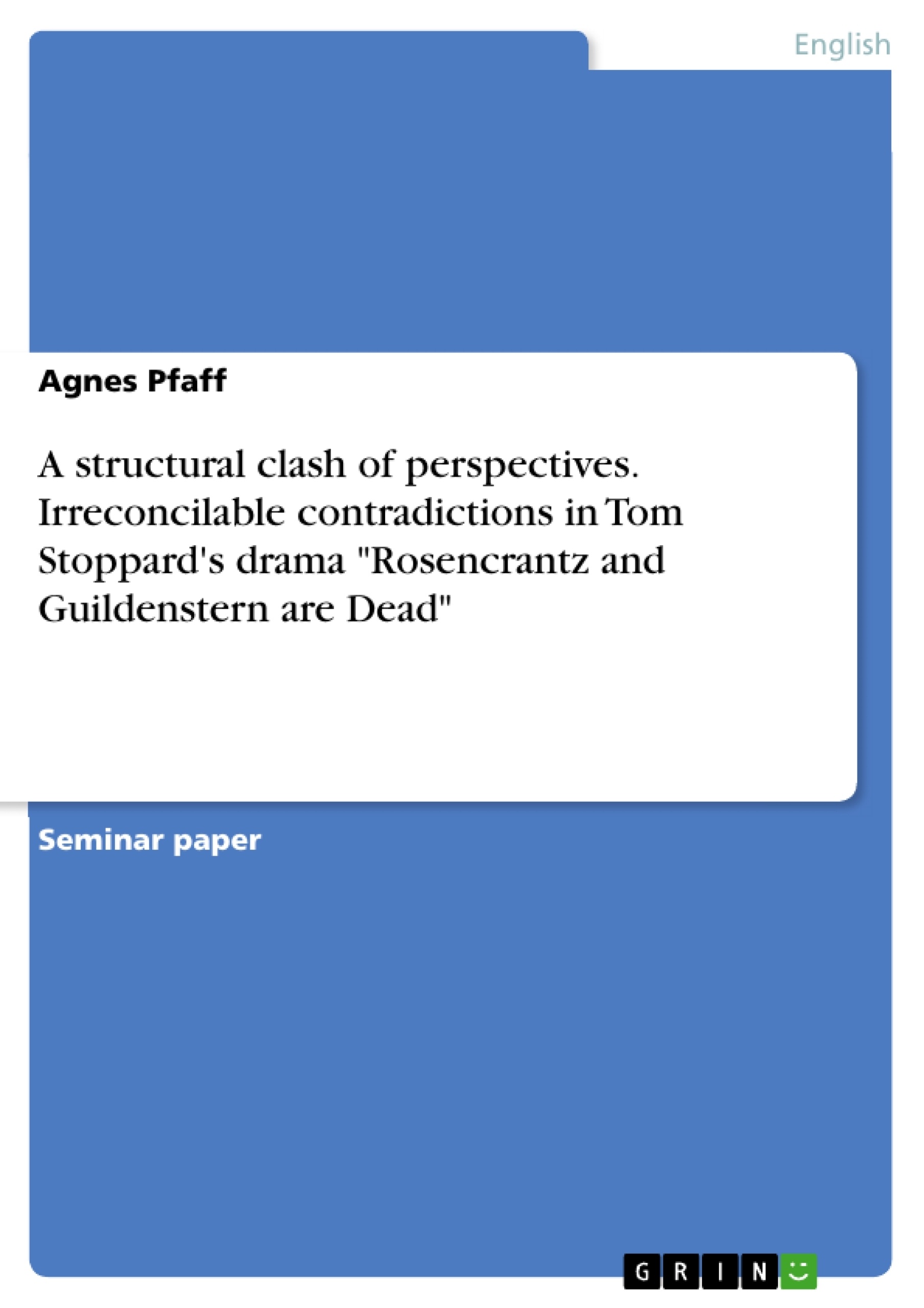The first part of this term paper is devoted to structural features of Stoppard’s play like the composition and combination of the plot, the coin metaphor (which is paradigmatic for the structure of “Rosencrantz and Guildenstern are Dead”) the reciprocal relationship between the audience and the play and the use of metadramatical elements. The main emphasis of the second part is put on the adaptation and inversion of the play’s dramatic predecessors “Hamlet” and “Waiting for Godot”. Furthermore, the different perspectives unfolded shall be compared, contrasted and examined as regards content.
A new form of art can only emerge from an investigation of the old, cultural possessions. Precisely this argument is dramatized in "Rosencrantz and Guildenstern are Dead" by means of comparing different models which try to introduce system and sense into the world, while none of them can claim to be of a general validity. The contradictions that have developed from man’s existential need to understand and adopt a structured world-view must be left standing side by side – a central perspective to dissolve them is not available since every stance is system-immanent and thus relative.
The concept of intertextuality implies the awareness that our ways of thinking and possible writing styles are always and inevitably shaped by the cultural conventions they stem from and also by the medium and the sign structures one has to make use of for the sake of articulation. The author does no longer pretend to be the original creator of an art work because he is well aware that he himself is a “cultural product” and that he has to make use of the literary repertoire, traditional stylistic devices, ideologies and conventions. Nevertheless, "Rosencrantz and Guildenstern are Dead" is neither an obvious intertextual assembly of quotations, a simple patchwork, nor is Stoppard a “theatrical parasite”.
Stoppard’s play evades the traditional genre typology. Because of its midway position between tragedy and comedy, parody and pastiche the play is conservative in taking over whole sequences of Hamlet literally and at the same time revolutionary because the distance towards the previous literary models serves to embed ancient moral concepts and thought into an ironic, postmodern context.
Inhaltsverzeichnis (Table of Contents)
- Introduction
- The structure of Rosencrantz and Guildenstern are dead
- The melting plot
- The symbol of the coin as a structural metaphor
- The ambiguous play with the audience
- Metadramatic elements in Rosencrantz and Guildenstern are Dead
- A clash of perspectives: Contradictory world-views in conflict
- Transformation and affirmation of the Hamlet plot
- Adaptation and inversion of “Waiting for Godot”
- Affinities in the characterisation of Ros and Guil to Beckett's tramps
- Differences in the dramatic conception of Waiting for Godot and Rosencrantz and Guildenstern are dead
- The postmodern attitude of the Player
- Final comment
Zielsetzung und Themenschwerpunkte (Objectives and Key Themes)
This term paper aims to examine the structure, themes, and dramatic influences of Tom Stoppard's play, Rosencrantz and Guildenstern are Dead. It explores the playwright's use of intertextuality, particularly his adaptation and inversion of Shakespeare's Hamlet and Samuel Beckett's Waiting for Godot.
- The play's structure and its utilization of the "melting plot" concept.
- The symbolic significance of the coin-tossing motif and its representation of paradoxical structures.
- The interplay between the audience and the play, including metadramatic elements and the ambiguous relationship between reality and fiction.
- The clash of perspectives and contradictory world-views presented in the play, highlighting the contrasting influences of Hamlet and Waiting for Godot.
- The postmodern attitude and the role of the Player as an epic mediator.
Zusammenfassung der Kapitel (Chapter Summaries)
- Introduction: This chapter sets the stage for the analysis by introducing the concept of intertextuality and how it plays a crucial role in Stoppard's play. It highlights the play's unique position as a blend of different dramatic models, while also emphasizing its potential for understanding without prior knowledge of the source material.
- The structure of Rosencrantz and Guildenstern are dead: This chapter delves into the play's structural features, beginning with the concept of the "melting plot" and its integration of both Hamlet and Waiting for Godot. It discusses the role of the Player as a mediator between these two worlds and the importance of the coin-tossing motif in highlighting the play's paradoxical structure.
- A clash of perspectives: Contradictory world-views in conflict: This chapter focuses on the play's exploration of different perspectives and world-views. It examines how Stoppard adapts and inverts the Hamlet plot, emphasizing the contrasting influences of Hamlet and Waiting for Godot. It explores the similarities and differences between the characters of Rosencrantz and Guildenstern and Beckett's tramps, as well as the postmodern attitude of the Player.
Schlüsselwörter (Keywords)
The central keywords and focus topics of this work include intertextuality, Hamlet, Waiting for Godot, "melting plot", metadrama, postmodernism, existentialism, absurdity, reality, fiction, and the Player.
- Citar trabajo
- Agnes Pfaff (Autor), 2016, A structural clash of perspectives. Irreconcilable contradictions in Tom Stoppard's drama "Rosencrantz and Guildenstern are Dead", Múnich, GRIN Verlag, https://www.grin.com/document/323861



